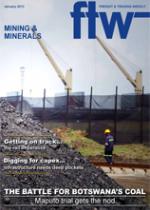For mining companies in
Africa, the single biggest
headache when setting up
is logistics. In many cases, the
mines are located deep inland,
but infrastructure like rail, and
often even decent roads, is
rudimentary, often non-existent.
Mining companies have to
make peace with the fact that
most of their capital spend in the
construction phase of a mine in
Africa will be to create a railway
and port facilities.
Bulk commodities, like iron
ore and coal, are particularly
challenging.
“You can move bulks by
truck, but most of it is done by
rail to be more economical and
efficient,” a logistics consultant
said.
A lot of the new iron ore
projects are in West Africa.
However, logistics in this
part of the continent is still
underdeveloped and the task falls
to the mining companies to build
the infrastructure.
“Iron ore is not a mining
game, it’s one of infrastructure,”
Benedikt Sobotka, MD of
consulting firm Bryanston
Resources, said.
“Even a sub-quality deposit
still has a chance to be developed
if you have a chance for
infrastructure,” ArcelorMittal
Liberia’s Joseph Matthews, head
of government and community
relations, said.
He noted that ArcelorMittal’s
iron ore deposit in Liberia was
“not such a great deposit”, but
infrastructure in the country
made development possible,
even if the rail that exists close to
the steelmaker’s deposit required
substantial rehabilitation.
ArcelorMittal Liberia expected
the first phase of its mine’s
development, which included the
250-km rail line’s rehabilitation,
to be around $1 billion.
However, Matthews said it
soon became apparent that the
cost would be closer to
$2 billion, because of the capital
the company had to spend on
rehabilitating the 250-km rail
line that runs from the mine to
the port.
Similarly the Sundance
Resources project, straddling
the borders of Cameroon and
Republic of Congo, estimates it
will need about $4.7 billion to
build its mine. Of this amount,
the infrastructure cost would take
up more than half of the capital.
Building a 510-km rail line to
the west coast port would cost
just over $2 billion, while the
port construction would come in
at $537 million.
Mining companies further
south face similar challenges
to the companies higher up
in Africa. Coal miners in
Mozambique are battling to
find partners to share the cost of
developing rail infrastructure in
the country.
Brazilian conglomerate Vale,
which has the Moatize mine in
Tete, has suffered a far-belowtarget
output from its mine in
2012 as a result of a delay in the
expansion of the existing Sena
rail line, which transports coking
coal from Moatize to the port of
Beira.
Vale expected to produce 6.37
million tonnes of coal at Moatize
in 2012, but has between January
and September only produced
2.8 million tonnes.
The mine can produce
11 million tpy and wants
to expand production to 22
million tpy in the second half
of 2014. However, the lack of
infrastructure could hamper the
company’s ambitions.
Restrictions on the Sena
line and Beira’s limited access
for larger cargo vessels have
motivated plans by Vale to build
a 1000-km rail line from Moatize
through Malawi to Nacala, where
Vale will also seek to build a
port. The cost of the project is
estimated at $4.4-5.2 billion.
Unsurprisingly, Vale’s CFO
Luciano Siani said in December
last year that the company was
seeking a partner for the Nacala
corridor development to share
costs.
Other companies have similar
plans. Kazakh miner ENRC
plans to start a tender process
for contractors to build its own,
privately funded 1200-km rail
line, also to Nacala.
However, none of these
projects will fly without funding.
INSERT
‘Even a sub-quality
deposit still has
a chance to be
developed if you
have a chance for
infrastructure’ –
ArcelorMittal
CAPTION
Mining companies must accept that most of their capital spend in the construction
phase of a mine in Africa will be to create a railway and port facilities.

